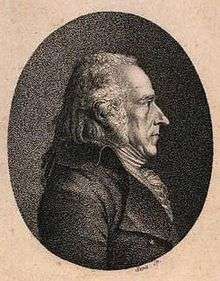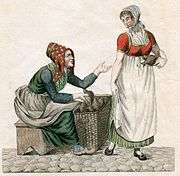Gerhard Ludvig Lahde
| Gerhard Ludvig Lahde | |
|---|---|
 | |
| Born |
October 19, 1765 Bremen |
| Died |
November 30, 1833 (aged 68) Copenhagen, Denmark |
| Nationality | Danish |
| Known for | Painting |
Gerhard Ludvig Lahde (19 October 1765 - 30 November 1833), usually referred to as G. L. Lahde, was a Preusian-born Danish printmaker and piblisher. He is remembered for his hand-coloured, slightly caricatured series of prints of traditional costumes created in collaboration with Johannes Senn as well as depictions of major jistoric events such as the Copenhagen Fire of 1795 and the Bombardments of Copenhagen in 1801 and 1807. He has also created many portraits of prominent people of his time.
Early life and education
Lahde was born in Bremen as the son of a taylor. After studying seven years in the local latin school, he went to Kiel where he completed an apprenticeship as a goldsmith. With ambitions to become an artist, together with Cladius Detlev Fritzsch, he then travelled to Copenhagen where he was admitted to the Royal Danish Academy of Fine Arts in 1787. He completed model school and was taught the craft of copperprint engraving by Johann Friderich Clemens. He won the small silver medal in 1790, the large silver medal in 1791 and the small gold medal in 1792. He initially worked as a goldsmith to pay for his education but without much economic succes and later turned to drawing and engraving portraits. His original plan was to return to Bremen and he received some economic support from his home town but decided to stay in Copenhagen and was naturalized in 1792.
Lahde's academic career was without much succes. In 1793, he tried to obtain status as agrée at the Academy with an engraving based on Jens Juel's portrait of August Hennings and in 1796 again with an engraving based on Anton Graff's portrait the Duke of Augustenborg.[1]
Career
He had more succes commercially as a portaist and was appointed to Engraver to the Danish Court in 1799. In 1803, he went abroad on a grant from Fonden ad usus publicos. In 1805, he was able to purchase a property in Gothersgade from where he ran a successful business. The young artists Christoffer Wilhelm Eckersberg and Johannes Senn boede lived in the building and worked for him.
Works
In spite of his technical skill and ability to combine different graphic techniques, Lahde's works are generally more of historic and cultural historic than artistic value. Many were hand-coloured by his daughters or his assistants. They were often published by himself in "series" or books. They often depicted current events such as the fire of Christiansborg Palace in 1794, the Copenhagen Fire of 1795 and the Bombardments of Copenhagen in 1801 and 1807. Other works include street scenes from Copenhagen, portraits of prominent people and series with traditional costumes.
Ladhe's "stambog"

Lahde's "stambog" I-II, npw kept in the Royal Danish Library, is a sort of guestbook which he notebooks he had with him on travels where people he met could write or make drawings. Most of the texts, drawings and gouachernes s are by young artists from the Art Academy, Mof of them unknown today but the two books contain drawings by F. Camradt, C. D. Fritsch, Hans Hansen, Johan Ludwig Lund, Elias Meyer, C. F. Stanley, Runge, Friedrich, Bertel Thorvaldsen and C. W. Eckersberg. Most of the drawings are of imaginary landscapes but some are of topographically identifiable scenes or portraits.[2]
Personal life
Lahde married Charlotte Dorothea Eleonore Werner in 1796 but she died in 1803. He married Marie Tonnum in 1820. He had three children. He was hit by a stroke in 1832 and died on 29 November 1833. He is buried at Assistens Cemetery.
List of publications
- Samling af fortjente Mænds Portrailer, 1798–1806, ("Collection of Portraits of Men of Merit, published in collaboration with R. Nyerup 1798–1806
- Mindesmærker paa Assistentskirkegaarden ved Kjøbenhavn, 1801–11 ("Memorials in Assistens Cemetery at Copenhagen, 1801-1811")
- Portrailer med Biographier ("Portraits with Biographies", 1805–06)
- Tolv Blade Figurer til Tegne-Øvelser efter Thorvaldsen (Twelf Sheets with Figures for Drawing Lessons after Thorvaldsen", 1814)
- Elementarværk i Tegnekunsten (1818–19)
- Klædedragter i København" udg ("Traditional costumes in Copenhagen# 1817-20)
Gallery
Garments of Copenhagen
 Skovser Women selling fish at Gammel Strand, c. 1800
Skovser Women selling fish at Gammel Strand, c. 1800.jpg) Collier at Kultorvet, c. 1805
Collier at Kultorvet, c. 1805 Valby Women selling poultry at Gammeltorv
Valby Women selling poultry at Gammeltorv.jpg) So-called "Ribbon Jew#
So-called "Ribbon Jew# Grocer, c. 1920
Grocer, c. 1920
References
- ↑ "G.L. Lahde" (in Danish). Dansk Biografisk Leksikon. Retrieved 16 September 2016.
- ↑ "G. L. Lahde: Stambog I" (in Danish). Royal Danish Library. Retrieved 16 September 2016.
External links
| Wikimedia Commons has media related to Gerhard Ludvig Lahde. |